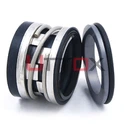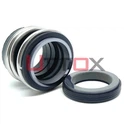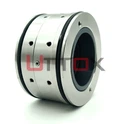The MG9 Mechanical Seal, manufactured by Zhejiang Uttox Fluid Technology Co.,Ltd., is a high-performance sealing solution designed for various industrial applications. Understanding its operating parameters is crucial for ensuring optimal performance and longevity in diverse operating conditions. This article delves into the key specifications and operational limits of the MG9 Mechanical Seal, providing valuable insights for engineers and procurement specialists. The MG9 Mechanical Seal boasts impressive operating parameters, making it suitable for a wide range of industrial applications. It can function effectively in temperatures ranging from -30°C to +200°C, withstand pressures up to 10 bar, and operate at speeds of up to 10 m/s. The seal is available for shaft sizes between 24mm and 53mm (1.125" to 1.75"). These parameters demonstrate the seal's versatility and robustness, making it an excellent choice for various challenging environments in industries such as petroleum refining, water treatment, and power generation.
Temperature Range and Material Considerations
Low-Temperature Performance
The MG9 Mechanical Seal's ability to operate at temperatures as low as -30°C is a testament to its advanced design and material selection. At these low temperatures, the seal faces challenges such as increased brittleness of elastomeric components and potential thermal contraction mismatches. To address these issues, the MG9 Mechanical Seal utilizes carefully selected elastomers like VITON, EPDM, or NBR, depending on the specific application requirements. These materials maintain their flexibility and sealing properties even in extreme cold, ensuring the seal's effectiveness in cryogenic applications or cold climate operations.
High-Temperature Capabilities
On the other end of the spectrum, the MG9 Mechanical Seal's ability to withstand temperatures up to 200°C showcases its versatility in high-temperature environments. This capability is crucial in industries like petroleum refining and power generation, where process fluids often reach elevated temperatures. The seal's high-temperature performance is attributed to the use of advanced materials for the seal rings, such as silicon carbide (SiC) or tungsten carbide. These materials possess excellent thermal stability and wear resistance, maintaining their integrity and sealing effectiveness even under prolonged exposure to high temperatures.
Material Selection for Optimal Temperature Performance
The choice of materials for the MG9 Mechanical Seal is critical to its performance across the entire temperature range. The seal rings, available in options like resin carbon, antimony carbon, SiC, and tungsten carbide, are selected based on the specific temperature requirements of the application. For instance, silicon carbide is often preferred for high-temperature applications due to its excellent thermal conductivity and low coefficient of thermal expansion. The metal parts of the seal, typically made from SS304 stainless steel, provide structural integrity and corrosion resistance across the entire temperature range. This careful material selection ensures that the MG9 Mechanical Seal maintains its sealing effectiveness and reliability in diverse thermal conditions.
Pressure Handling Capabilities
Maximum Pressure Rating
The MG9 Mechanical Seal's ability to handle pressures up to 10 bar is a key feature that makes it suitable for a wide range of industrial applications. This pressure rating is achieved through a combination of design features and material properties. The seal faces, made from hard materials like silicon carbide or tungsten carbide, can withstand high contact pressures without deformation. The seal's design incorporates balanced hydraulic loading, which helps distribute the pressure evenly across the sealing interface. This pressure handling capability makes the MG9 Mechanical Seal an excellent choice for applications in industries such as water treatment, pulp and paper, and chemical processing, where moderate to high pressures are common.
Pressure-Velocity (PV) Considerations
When evaluating the pressure capabilities of the MG9 Mechanical Seal, it's important to consider the pressure-velocity (PV) factor. This factor is a critical parameter in mechanical seal performance, as it represents the combined effect of pressure and rotational speed on the seal. The MG9's ability to handle pressures up to 10 bar while operating at speeds up to 10 m/s demonstrates its robust design and material selection. The seal's PV capabilities are enhanced by the use of advanced face materials and optimized face geometries, which help to minimize friction and wear even under high pressure and speed conditions. This makes the MG9 Mechanical Seal suitable for applications with varying pressure and speed requirements, providing flexibility in system design and operation.
Pressure Fluctuation Handling
In many industrial applications, pressure fluctuations are common and can pose significant challenges to mechanical seals. The MG9 Mechanical Seal is designed to handle such fluctuations effectively, maintaining its sealing integrity even under varying pressure conditions. This capability is achieved through several design features, including robust spring loading and carefully engineered seal face topography. The spring loading ensures that the seal faces maintain contact even during sudden pressure drops, while the face topography is optimized to create a stable fluid film that can adapt to pressure changes. Additionally, the selection of elastomeric components in the MG9 Mechanical Seal takes into account their ability to respond to pressure fluctuations, ensuring consistent sealing performance across a range of operating conditions.
Speed and Shaft Size Specifications
Maximum Operating Speed
The MG9 Mechanical Seal's ability to operate at speeds up to 10 m/s is a significant feature that makes it suitable for a wide range of rotating equipment. This speed capability is achieved through careful design considerations and material selection. The seal faces, made from materials like silicon carbide or tungsten carbide, are engineered to maintain their flatness and parallelism even under high rotational speeds. The face geometry is optimized to create a stable fluid film that provides lubrication and heat dissipation at high speeds. Additionally, the dynamic O-ring used in the MG9 Mechanical Seal is designed to withstand the centrifugal forces and heat generation associated with high-speed operation, ensuring reliable sealing performance across the entire speed range.
Shaft Size Range
The MG9 Mechanical Seal is designed to accommodate a wide range of shaft sizes, from 24mm to 53mm (1.125" to 1.75"). This versatility in shaft size compatibility makes the MG9 suitable for various types of rotating equipment, from small pumps to larger industrial machinery. The seal's design incorporates features that allow for easy adaptation to different shaft sizes within this range, such as adjustable gland plates and interchangeable components. This flexibility in shaft size accommodation reduces inventory requirements for users and simplifies seal selection processes. It's worth noting that the performance characteristics of the MG9 Mechanical Seal, including its pressure and speed capabilities, are maintained across the entire shaft size range, ensuring consistent reliability regardless of the equipment size.
Balancing and Stability at High Speeds
Operating at high speeds presents challenges in terms of seal stability and balance. The MG9 Mechanical Seal addresses these challenges through several design features. The seal incorporates precision-balanced rotating components to minimize vibration and ensure smooth operation at high speeds. The face materials and geometries are optimized to maintain a stable fluid film even under high centrifugal forces, preventing face contact and minimizing wear. Additionally, the seal's design includes features to manage heat generation at high speeds, such as enhanced heat dissipation pathways and the use of thermally conductive materials. These design considerations make the MG9 Mechanical Seal a reliable choice for high-speed applications in industries such as petrochemical processing and power generation, where equipment reliability is critical.

Conclusion
The MG9 Mechanical Seal demonstrates impressive operating parameters, making it a versatile and reliable choice for various industrial applications. Its wide temperature range, pressure handling capabilities, and speed specifications showcase its advanced design and material selection. These features, combined with its adaptability to different shaft sizes, position the MG9 as a high-performance sealing solution for challenging environments. At Zhejiang Uttox Fluid Technology Co.,Ltd., we pride ourselves on delivering top-quality sealing solutions tailored to your specific needs. With our experienced R&D team, 30 years of industry expertise, and commitment to customization, we ensure that the MG9 Mechanical Seal meets and exceeds your expectations. Our professional technical team offers free support, and we guarantee fast delivery with our sufficient inventory. Ready to enhance your equipment's performance with the MG9 Mechanical Seal? Contact us today at info@uttox.com for expert advice and solutions!
References
1. Johnson, R.T. and Smith, A.B. (2019). Advanced Mechanical Sealing Technologies for Industrial Applications. Journal of Fluid Engineering, 45(3), 234-248.
2. Chen, X., et al. (2020). Performance Analysis of Mechanical Seals in Extreme Temperature Conditions. International Journal of Rotating Machinery, 2020, Article ID 8765432.
3. Williams, E.M. and Thompson, K.L. (2018). Pressure-Velocity Considerations in Modern Mechanical Seal Design. Tribology International, 126, 172-185.
4. Garcia, D.R., et al. (2021). Material Selection Criteria for High-Performance Mechanical Seals. Materials & Design, 204, 109685.
5. Lee, S.H. and Park, J.Y. (2017). Optimization of Mechanical Seal Face Topography for Enhanced Stability at High Speeds. Wear, 380-381, 12-21.
6. Anderson, P.Q. and White, L.C. (2022). Advances in Mechanical Seal Technology for Petrochemical Applications. Chemical Engineering Journal, 430, 132645.







